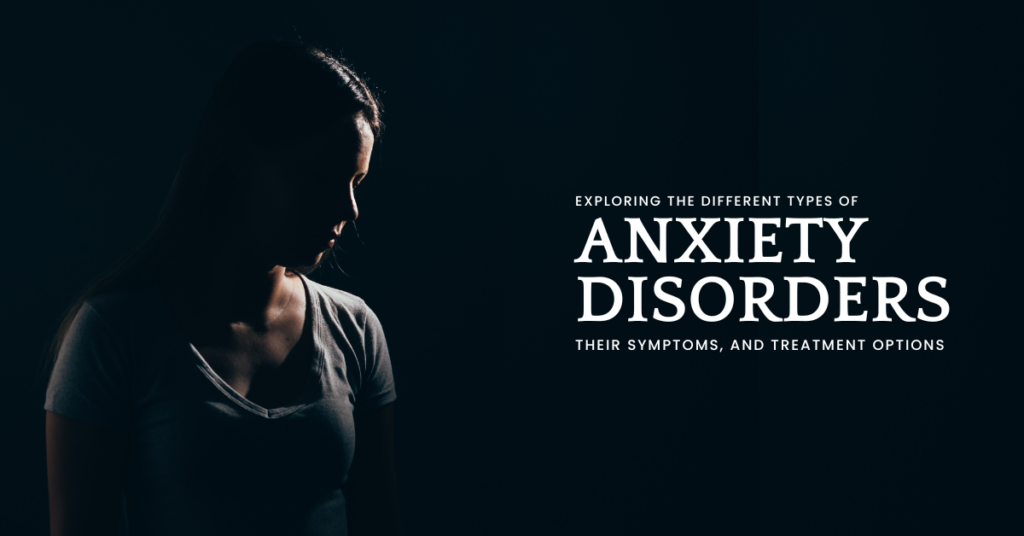
Exploring the different types of anxiety disorders, their symptoms, and treatment options:
Anxiety is a typical human emotion. It is that sensation of anxiety, trepidation, or uneasiness that develops in reaction to stressful circumstances or imagined threats. While occasional anxiety is natural, anxiety disorders may be indicated when it becomes excessive, chronic, and interferes with day-to-day activities.
A class of mental health illnesses known as anxiety disorders is defined by excessive and uncontrollable sensations of fear and worry. Their impact on an individual’s capacity to perform in social, academic, and occupational contexts can be substantial.
This blog explores the various forms of anxiety disorders, their signs and symptoms, and practical solutions for therapy. We can empower ourselves and others to get treatment and effectively manage anxiety by being aware of these problems.
Anxiety Disorder Types:
Generalised Anxiety Disorder (GAD): Individuals with GAD worry excessively and chronically about a wide range of topics, most frequently ordinary ones like relationships, money, or health. Physical manifestations of this anxiety include headaches, tiredness, tense muscles, and trouble sleeping.
Panic Disorder: The physical symptoms of panic disorder appear swiftly and reach their climax within minutes. They are also characterised by the abrupt onset of panic attacks and severe episodes of overpowering terror. Heart palpitations, breathlessness, pressure in the chest, light-headedness, and perspiration are a few of these symptoms. Fear of more panic attacks is a common symptom of panic disorder, which causes avoidance behaviours.
Social Anxiety Disorder (Social Phobia): Social anxiety disorder involves an intense fear of social situations where a person may be scrutinized or judged by others. People with this disorder may experience anxiety about public speaking, eating in front of others, or attending social gatherings. Physical symptoms like blushing, trembling, and nausea can also accompany social anxiety.
Specific Phobias: Specific phobias are intense fears of specific objects or situations, such as spiders, heights, flying, or enclosed spaces. These phobias can be so severe that they trigger panic attacks and lead to avoidance behaviours that significantly restrict a person’s life.
Agoraphobia: Agoraphobia is an anxiety condition defined by a fear of potentially panic-inducing situations or a trapped, ashamed, or powerless feeling. Avoiding crowded areas, using public transit, or even just leaving the house can result from this phobia.
Separation Anxiety: This usually affects young children who exhibit excessive worry when they are separated from their primary carers. While they are apart, they could be concerned that something terrible will happen to them or their carer.
Selective Mutism: People with this uncommon anxiety disease, although they can talk in other contexts, find it difficult to communicate in social situations. For kids, this can be especially difficult in school settings.
Symptoms of Anxiety Disorders:
While the specific symptoms may vary depending on the type of anxiety disorder, some common ones include:
Excessive worry and fear
Restlessness or feeling on edge
Irritability
Fatigue
Muscle tension
Headaches
Difficulty sleeping
Difficulty concentrating
Panic attacks (in some cases)
Avoidance behaviours
Options for Anxiety Disorder Treatment:
Anxiety problems are fortunately quite curable. Here are a few efficient therapy choices:
The most effective therapy for anxiety disorders is cognitive-behavioural therapy, or CBT. It assists people in recognising and altering harmful thought patterns and actions that fuel their worry.
In a secure and supervised setting, exposure therapy gradually exposes patients to the circumstances or items they find frightening. This lessens their avoidance behaviours and teaches them how to control their worry.
Relaxation methods: Methods including progressive muscle relaxation, deep breathing, and meditation can help people control their physical symptoms of anxiety and improve their general well-being.
Medication: In some cases, medication such as antidepressants or anti-anxiety medications may be prescribed by a doctor to help manage symptoms.
Living with Anxiety:
Here are some additional tips for managing anxiety:
Maintain a healthy lifestyle: Regular exercise, a balanced diet, and adequate sleep can significantly improve anxiety symptoms.
Limit caffeine and alcohol: These substances can worsen anxiety symptoms.
Connect with others: Social support can be a powerful buffer against anxiety. Talk to trusted friends, family members, or a therapist.
Practice self-care: Engage in activities you enjoy, like hobbies, spending time in nature, or listening to music.
Strategies for Coping with Anxiety Disorders:
Long-term management of anxiety disorders requires treatment, but there are other useful coping strategies that can offer people instant comfort and give them the confidence to face everyday obstacles. Here are some methods to think about:
Mindfulness: Techniques such as focused breathing meditation can assist people in becoming nonjudgmentally aware of their thoughts and feelings. They can break free from nervous ruminating and lessen their level of anxiety all around by grounding oneself in the here and now.
Journaling: Putting your fears and anxieties on paper can be a very therapeutic exercise. Additionally, journaling can be utilised to pinpoint triggers and monitor development over time.
Challenging Negative Thoughts: Anxiety often stems from distorted thinking patterns. Cognitive reframing involves challenging negative thoughts and replacing them with more realistic and helpful ones.
Time Management and Organization: Feeling overwhelmed by tasks can exacerbate anxiety. Creating to-do lists, prioritizing tasks, and setting realistic goals can help individuals feel more in control and reduce stress.
Putting Together a Support Network:
It might be lonely to have an anxiety disorder, but good anxiety management depends on having a solid support network. Here are a few strategies for creating a network of support:
Speak with Loved Ones: You can develop empathy and understanding by discussing your difficulties with dependable friends and family members. Their assistance can be really helpful when things are hard.
Think about therapy groups: Support groups help people find people who can relate to what they’re going through. It can be quite beneficial to share experiences and coping mechanisms in a secure setting.
Online Support Communities: People can connect with others going through similar struggles by participating in online forums and communities. These groups can provide support, knowledge, and a feeling of community.
Remember:
Although coping techniques can be effective tools for managing anxiety both in the moment and on a regular basis, they should not be used in place of professional treatment. A supportive network, self-care techniques, and good treatment can enable people with anxiety disorders to lead fulfilling lives.
Taking Responsibility for Your Health:
Though common, anxiety disorders don’t have to define who you are. You may take responsibility for your mental health and lead a life free from excessive stress and fear if you have the right information, access to efficient treatment alternatives, and self-care practices. You may give yourself the power to control your worry and prosper by putting the techniques discussed in this blog into practice and asking for assistance when required.



